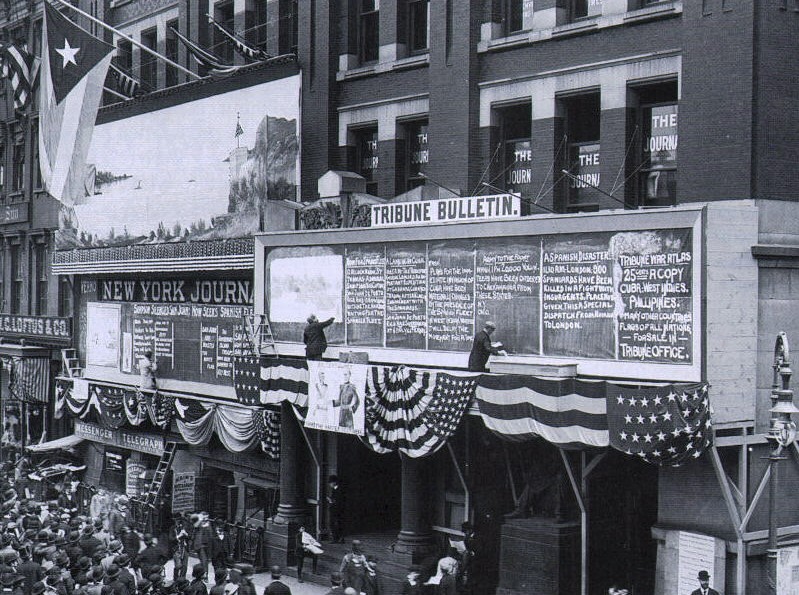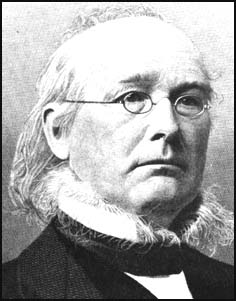
History of the Tribune | Horace Greeley, Founder
Stories of the Time | Timeline (Fictional)
The Founding of the Tribune
His success in political journalism cemented Greeley's friendship with Whig leaders in New York state, and with their encouragement he issued the first number of the New York Tribune on Apr. 10, 1841. He edited this paper for over 30 years; during much of that time it was the greatest single journalistic influence in the country. From the first, Greeley's object was to provide for the poor a paper that was as cheap as those of his rivals but less sensational and more probing than the "penny press." Therefore, sensational police news and objectionable medical advertising were eliminated from the Tribune.
Greeley's chief editorial assistant for 15 years after 1846 was Charles A. Dana. Beginning in 1849, George Ripley conducted for 30 years the first regular literary and book review department in a U.S. newspaper. Other talented men joined Greeley's staff (he was the first editor to allow by-lines), but his own clear, timely, vigorous editorials were the feature that made the Tribune known throughout the nation.
~From "Horace Greeley", Columbia Electronic Encyclopedia Press
�
The New York Tribune, From The Encyclopedia of New York
Daily newspaper launched by Horace Greeley in 1841. It supported Whig politics and reformist causes favored by its publisher, including temperance, the labor movement, utopian socialism, and opposition to the expansion of slavery. The staff during the 1840s included Solon Robinson and George "Gaslight" Foster, who together wrote about the plight of the city's slum dwellers and sweatshop works, and the feminist Margaret Fuller. It also published a weekly edition that was the most influential Republican newspaper in the nation and by the 1850s had a circulation of more than 200,000. The newspaper was instrumental in persuading Lincoln to enact the Emancipation Proclamation in 1863. It was purchased by the editor Whitelaw Reid in 1872, under whose direction it took a more conservative turn and engaged in an eight-year battle (1884-1892) with striking printers. In 1886 the Tribune was the first newspaper to install Otmar Mergenthaler's slug-casting linotype machine which revolutionized typesetting. Reid's son Ogden Reid Sr. became the president and managing editor in 1912; with his wife Helen (Miles) Rogers Reid he revamped the newspaper's news coverage and layout. In 1924 the Reid family bought the New York Herald and merged it with the Tribune to form the New York Herald Tribune.
~Steven H. Jaffe (More thanks to Spit for finding this article)
�
�

January 8, 1902
A train collision beneath New York City's Grand Central Station, caused by poor visibility due to steam in the tunnels, results in a ban on steam engines on Manhattan commuter trains.
January 25, 1902
The Broadway musical Floradora plays its 505th performance, setting a record for length of run.
January 27, 1902
5 construction workers on New York's IRT subway are killed in an explosion.
March 21,1902
A subway tunnel under New York City's Park Avenue near 38th Street collapses, destroying three mansions.
June 9, 1902
West Point Military Academy celebrates its first 100 years.
July 12, 1902
The Twentieth Century Limited sets the train speed record on a run between New York City and Chicago.
October 26,1902
Suffragette Elizabeth Cady Stanton dies in New York City.
November 3, 1902
Clyde Fitch's The Stubbornness of Geraldine opens at Broadway's Garrick Theatre.
November 4, 1902
There was an explosion and fire in Madison Square Garden. 15 people were killed, 70 were injured.
November 11, 1902
Roland B. Molineux is acquitted in New York City after a second trial, for the 1889 murder of elderly widow Margaret Adams.
November 17, 1902
A U. S. production of The Eternal City opens at New York's Victoria Theatre.
�
�
Horace Greeley, Founder | Back
"Go West, Young Men"

Horace Greeley was born
in Amherst, New Hampshire, on 3rd February, 1811. He trained as a
printer but he later moved to New York City where he became a
journalist. Greeley worked for the New Yorker and in 1841
established the New York Tribune. A newspaper he was to
edit for over thirty years.
Greeley took a strong moral tone in his newspaper and campaigned
against alcohol, tobacco, gambling, prostitution and capital
punishment. However, his main concern was the abolition of
slavery.
In 1838 Greeley agreed to edit the Jeffersonian, a Whig
newspaper in New York. A close associate of William Seward, Henry
Clay, William Harrison, he edited the pro-Whig journal, Log
Cabin, during the 1840 presidential election.
Greeley was very interested in socialist and feminist ideas and
published articles by Karl Marx, Charles Dana, Margaret Fuller
and Jane Grey Swisshelm in the New York Tribune. He also
promoted the views of Albert Brisbane, who wanted society
organised into co-operative communities.
After the demise of the Whigs, Greeley supported the Free Soil
Party. He was one of the leaders of the campaign against the 1850
Fugitive Slave Law and in 1856 helped form the Republican Party.
In 1860 Greeley supported the presidential campaign of Abraham
Lincoln. However, Greeley, like many of the strong opponents of
slavery, was unhappy with the way Lincoln dealt with John C.
Fremont and David Hunter when they freed slaves in territory they
captured from the Confederate Army during the Civil War.
On 19th August, 1862 Greeley wrote an open letter to the
president in the New York Tribune. In the letter Greeley
critized Abraham Lincoln for failing to make slavery the dominant
issue of the war and compromising moral principles for political
motives. Lincoln famously replied on 22nd August, "My
paramount object in this struggle is to save the Union, and is
not either to save or destroy slavery. If I could save the Union
without freeing any slave, I would do it; and if I could save it
by freeing all the slaves, I would do it."
Greeley wrote several books including Glances at Europe (1851),
An Overland Journey (1860), a two volume history of the
Civil War, The American Conflict (1865), and an
autobiography, Recollections of a Busy Life (1868).
Greeley was highly critical of the presidency of Ulysses G. Grant
and became associated with the Radical Republicans. Later he
helped form the Liberal Republican Party.
In 1872 he Liberal Republican Party nominated Greeley as their
candidate and he stood against Ulysses G. Grant for the
presidency. During the campaign Thomas Nast produced a series of
cartoons attacking Greeley. He commented that the venom of these
cartoons were so bad that he "scarcely knew whether he was
running for the presidency or the penitentiary." Greeley,
won 40% of the popular vote but died soon afterwards on 29th
November, 1872. One friend claimed that he had been "crushed
by the unmerciful ridicule Nast had heaped on him."
�
�
1841
April 10- Horace Greeley founds the New York Tribune.
1849
George Ripley begins the first literary and book review department in a U.S. newspaper.
1872
Editor Whitelaw Reid purchases the newspaper.
1884
Printers go on strike.
1886
Becomes first newspaper to install Otmar Mergenthaler's slug-casting linotype machine.
1892
Strike ends.
1902
�